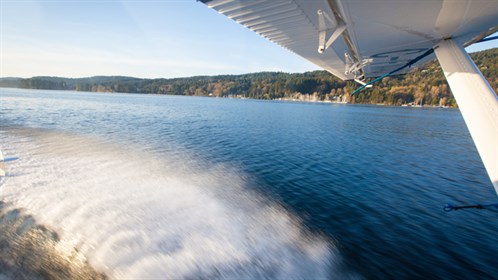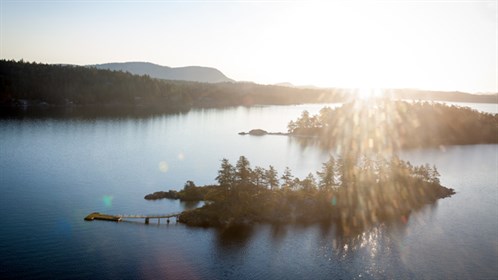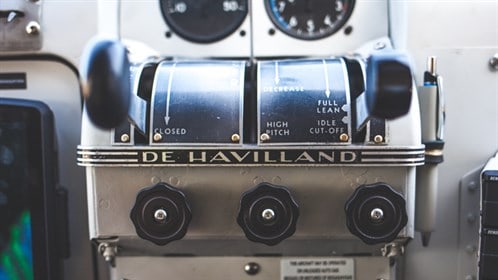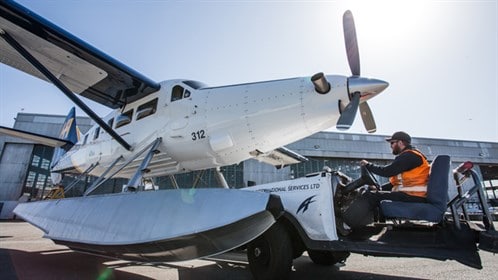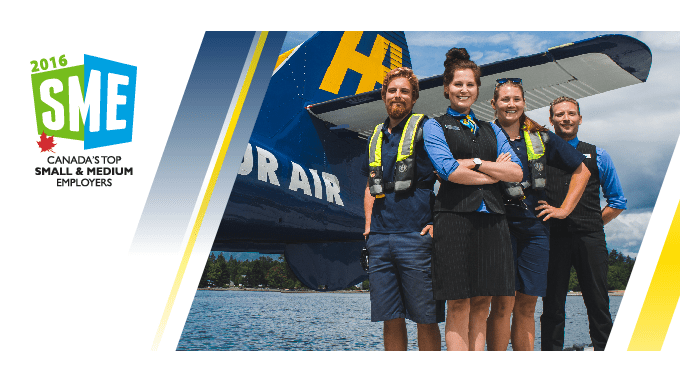
Harbour Air Recognized as Top Employer
Harbour Air Awarded Canada’s Top Small & Medium Employers for 2016
March 29, 2016, Vancouver – Harbour Air, one of the world’s largest seaplane airlines, is proud to be recognized today as one of Canada’s Top Small and Medium Employers for 2016.
“We are honoured to receive this national award recognizing our efforts as an employer in providing peer to peer reward and recognition programs as well as our extensive health and wellness initiatives. We strive to ensure that all members of our team are recognized every day for the contributions that they make to our ongoing success,” said CEO Greg McDougall, founder of Harbour Air and its groups of companies.
Canada’s Top Small & Medium Employers award acknowledges the small and medium enterprises (SMEs) that offer the nation’s best workplaces and forward-thinking thinking employment support services and benefits. Harbour Air is being recognized for its commitment to employee health, training and apprenticeships.
“This year’s winners provide striking examples of smaller organizations ‘getting it right’ on a range of important benefits, from maternity leave to flexible vacation policies,” Richard Yerema, Managing Editor of the Canada’s Top 100 Employers project.
Harbour Air is North America’s first carbon-neutral airline. The airline and its employees are an essential part of British Columbia’s tourism and commuter air transport infrastructure, transporting more than 400,000 passengers every year.
Media contact:
Samantha Kent
Marketing Manager, Harbour Air Group
Email: skent@harbourair.com
Office: 604.233.3526
To learn more about Canada’s Top Small and Medium Employers Award, click here
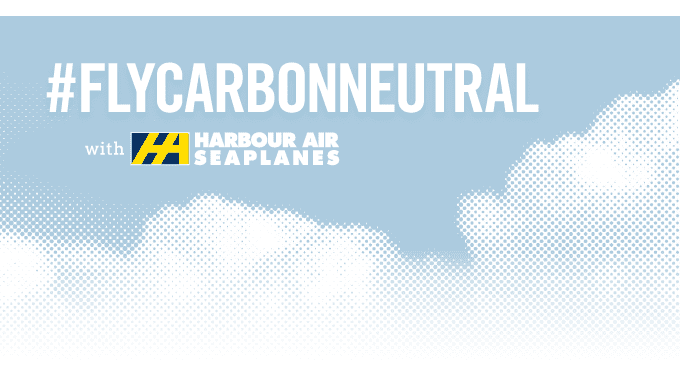
Harbour Air Seaplanes, North America’s First Carbon Neutral Airline, Commences Tenth Year of Measuring, Reducing and Offsetting GHG Emissions
Airline’s 2014 offsets are equivalent to taking 2,321 cars off the road
February 24, 2016, Vancouver, BC – Offsetters Climate Solutions, a division of NatureBank Asset Management, and Harbour Air Seaplanes have released the 2014 results from the airline’s carbon reduction and offsetting programs. Harbour Air, North America’s first carbon neutral airline, has worked to manage its greenhouse gas emissions (GHG)with Offsetters Climate Solutions since 2007. As Harbour Air and Offsetters work to calculate the 2015 GHG emissions and reducing those in the future, Harbour Air moves into the tenth year of collaborating with Offsetters.
Harbour Air Seaplanes carried more than 350,000 passengers on its routes in 2014, with the airline offsetting 100 percent of their emissions associated with seaplane fuel use and corporate operations. Combined, this resulted in the airline offsetting over 10,000 tCO2e, which is an equivalent to taking approximately 2,300 cars off the road. Of this footprint, 94 percent comes from seaplane fuel use. For example, flying from Vancouver to Victoria – Harbour Air Seaplanes’ busiest route – each passenger emits approximately 8 kg of CO2e per passenger per flight.
“Over the past ten years Offsetters Climate Solutions has worked with Harbour Air Seaplanes to find ways to develop, improve, and implement carbon management and carbon offsetting programs. This relationship has allowed both companies to showcase to consumers how a small investment can result in huge dividends for the environment,” says James Tansey, CEO of NatureBank Asset Management. “The investment made by Harbour Air Seaplanes has allowed them to improve their efficiency, while supporting carbon offset projects in our province and around the world.”
While the 2014 results alone are substantial, when viewed as a combined total over the past eight years, Harbour Air Seaplanes stands as a leader in business and sustainability in British Columbia, developing and enhancing their #FlyCarbonNeutral program. Since 2007, the airline has offset over 73,000 tonnes and has flown over 2.8 million passengers. Harbour Air Seaplanes’ have seen emissions, per revenue dollar, decrease by 15 per cent over the past two years.
“Harbour Air is proud to be North America’s first carbon neutral airline offsetting all GHG emissions from flight and corporate operations since 2007, with the help of Offsetters,” says Meredith Moll, Vice President of Sales and Marketing at Harbour Air. “We thank our passengers and our staff for their commitment to our carbon neutral program, which has been an important part of Harbour Air’s commitment to environmental sustainability.”
Harbour Air’s offsets have contributed to the protection of the Great Bear Rainforest and HaidaGwaii through the Great Bear Forest Carbon Project. This project covers over 7 million hectares and is an Improved Forest Management project along the North and Central-Mid Coast of British Columbia. The airline has also invested in Offsetters Climate Solutions’ Ugandan Wood Cookstoves program, which replaces conventional cookstoves with a more efficient stove. Over the past two years, offsets from Harbour Air passengers have subsidized over 7,000cookstoves.
#FlyCarbonNeutral by the numbers:
- Canada’s Best Managed Company Award 2009-2015
- The Mail Run Tour is one of Destination Canada’s Signature Experience since 2011
- YVR Port Authority 2015 Clear Skies Award
- Calculating Carbon Emissions since 2007
- 2.8 million passengers from May 2007 to February 2015
- 0.496kg of Co2e Emissions per passenger kilometre
- 94 percent of these emissions came from seaplane fuel use in 2014
- Over 73,000 tonnes in carbon offsets since October 2007
- Vancouver owned
- Employs more than 400 local staff during high season
- 913 Flight vouchers donated to charities and sponsorships during 2014
- Use Hemlock Printers to print more than 170,000 carbon neutral brochures
- In 2014, Harbour Air offset 10775.1 TCO2e. This is equivalent to getting 2,321 cars off the road
- Harbour Air offsets 100 percent of their emissions
- North America’s first fully carbon neutral airline
- Flying return from Vancouver to Victoria emits 8kg of CO2e per passenger per flight
- Founding participants of the Earth Day clean up in Victoria. In 2015 more than 60,000 pieces of garbage were picked up
- Harbour Air’s offsets have contributed to the protection of the Great Bear Rainforest and HaidaGwaii. These carbon projects cover more than 7 million hectares
- Offsets from travel for the past two years have subsidized more than 7,375Ugandan cookstoves
- Over the past two years emissions per revenue dollar have decreased 15 percent
- Since 2007 total emission per revenue dollar have decrease 18 percent
About Offsetters Climate Solutions, a division of NatureBank Asset Management
Offsetters Climate Solutions, a division of NatureBank Asset Management, is Canada’s largest and most diversified carbon management solutions provider. Its team of industry leaders specializes in a comprehensive offering of sustainability consultancy services to help organizations understand, reduce, and offset their climate impact.
NatureBank Asset Management specializes in advisory, technology and impact project investment services that create value and enhance sustainable commodities and ecological assets while managing climate change risk and maximizing long-term investment in nature. NatureBank provides their customers with a multidisciplinary approach to manage risk, enhance asset performance and secure commercial returns while improving livelihoods and sustainability. For more information, visit www.naturebank.com.
About Harbour Air Seaplanes
Harbour Air was founded in BC in 1982 and today has more than 50 aircrafts, servicing 400,000 passengers throughout coastal British Columbia. The Harbour Air Group, consisting of Harbour Air Seaplanes, Whistler Air, Saltspring Air Tantalus Air and Aeroflite International Services is one of the largest seaplane company in the world. For more information, please visit staging.harbourair.com.
Media contacts:
For Offsetters Climate Solutions, a division of NatureBank Asset Management:
Brian Cant, Tartan Group: 250-592-3838 or brian@tartangroup.ca
Natalie Farrell, Offsetters Climate Solutions: 778-887-6049 or natalie.farrell@offsetters.ca
For Harbour Air Seaplanes:
Samantha Kent, Harbour Air Seaplanes: 604-233-3526 or skent@harbourair.com

The 16th Annual Vancouver Island Business Excellence Awards, held Thursday, January 21st at the Coast Bastion Hotel in Nanaimo saw Harbour Air Seaplanes honoured with the award for Business of the Year.
Harbour Air was among 15 other organizations honoured by the Business Examiner as a part of the 2016 Vancouver Island Business Excellence Awards.
“Some truly amazing businesses were honoured at the awards, and deservedly so,” says Mark MacDonald of Business Examiner, which coordinated the event. “There are some very positive stories, and it’s astonishing to see the variety of ideas that have become successful businesses all across Vancouver Island.”
Harbour Air operates a fleet of Canadian made de Havilland Beaver, Single Otter and Twin Otter aircraft renowned the world over their capability, reliability and history. Harbour Air Seaplanes has been in business for over 33 years and transports over 400,000 passengers throughout coastal British Columbia every year.
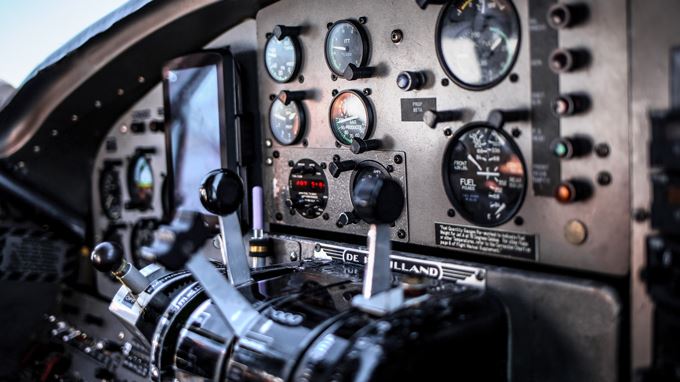
Airplanes, It’s a Life Long Obsession
Shawn Braiden is a difficult man to find.
When he’s not on the floor in Harbour Air’s South Vancouver-based hangar directing traffic, he’s spending time with his growing family or soaring through the skies in his own personal aircraft.
You see, for Harbour Air’s PRM (Person Responsible for Maintenance) for Aeroflite International, aviation is more than a job, it’s a lifelong obsession.
Shawn’s a busy guy, but I was able to catch up with him a couple weeks ago to learn more about working for a seaplane company.
Kelvin: First off, it’s fairly obvious you’re pulled in many different directions, right?
Shawn: Yep.
What’s your official title and role here?
My official title is Person Responsible for Maintenance (or PRM) for Aeroflite International Services Ltd. I’m the PRM for Harbour Air Ltd., West Coast Air Ltd., Harbour Air Vertical, which is the helicopter division of Harbour Air, and the PRM of Harbour Air’s manufacturing division as well as Tantalus Air.
It sounds like you’ve got like seven different jobs all in one day.
It’s the same sort of job but it’s for all the different airlines and different spots.
Which part do you enjoy the most?
I’m an aircraft freak. I love airplanes. I’ve always been involved with airplanes. If it’s not fixing airplanes, it’s flying airplanes, it’s looking at airplanes, it’s anything airplanes.
Pretty much my whole life I’ve been obsessed. I’ve been flying model airplanes since I was 10 or 12 and building models prior to that. I’ve always been interested in airplanes.
How did that passion bring you here to Harbour Air?
I grew up over on Salt Spring Island and I was neighbours with St. Clair McColl. He’s one of the guys that runs Saltspring Air. That’s how I got involved with Harbour Air or got to know about Harbour Air, through St., and then we had some other friends who worked for helicopter outfits and worked for other different things. I would get to poke my head in and get involved with aviation that way and then basically once I left high school, I got my pilot’s license in Victoria and worked at the Victoria Flying Club.
I went to BCIT in the AME (Aircraft Maintenance Engineering) program. I had my first apprentice job before finishing my schooling at BCIT just washing planes and other odds and ends. Once finishing, I was hired and I came over and visited Bob Bater who was in charge of the hangar here, the Chief Engineer at the time, I got hired running the maintenance part of Harbour Air.
What made you decide to build the planes instead of flying them?
It was really just an opportunity that came up and that’s about it. I’m still very interested in doing the flying, I don’t know if I’d ever go off and try to do it commercially but I still enjoy flying a lot. A lot of the guys that I talk to who fly commercially now, they don’t fly on their days off because it’s their job, they need a break. Me on the other hand, I’m always flying on my days off or wrenching on my days off. So it doesn’t seem to bother me which one it is so if one day I go off to fly commercially here or something or do the odd bit of flying, who knows?
Right now, I’m more than busy with the stuff I’m doing now, which is great.
A lot of people report to you. What’s your management style? How do you get the job done in so many different areas?
I’m always learning as I go, and I think the guys appreciate that. I do get feedback back from time to time from different guys and sometimes I change the way I’m doing things and sometimes I don’t. It’s a constant learning process. What that style is I don’t know if I could put a name to it.
I think that’s your style right there, to try to keep learning. People feed off that and it makes them want to improve too.
Yeah. Just constantly learning. I work with some other managers here that are really good. We all get along really well together. We work well as a team. I don’t think I could do it without them so it all works out really well that way.
This is going to be a loaded question, I’ll tell you right now. Just describe a typical day here for you.
A typical day? Oh man.
You only get two minutes, too.
Gotcha. I get here usually at 6 am. Meet up with some of the guys for coffee. We talk about what was going on the day before and world events and whatever else. Solve the world’s problems, you know.
Good. Thanks for that by the way.
No problem. We talk to the pilots in the morning, they come in to check their airplanes. We give them a hand pulling the airplanes out, put them in the water etc.
You have to do that everyday?
Yeah we do that everyday. It’s usually Chris, one of the guys in the hangar, he does a lot of the actual launching now. So we put the airplanes in the water and then turn the fuel on and I try to go visit dispatch if I can, see how things are going with them. Come back to the shop, make sure all the guys in the sheet metal department, they all start at 7, make sure they’ve all got stuff to work on, and they’re all happy and they have everything they need to get their job done and if they need me I try and support them to get their stuff done.
Then Wayne comes in and he’s got a few projects he’s working on so I try to leave him alone. I’m there making sure all the guys in the west hangar have things to do, have everything they need and then it’s usually taking care of emails and solving issues that are going on in different locations. And it all depends on the day, some days are more challenging than others. And then I work with both Erika’s (Maintenance & Engineering & Quality managers), Kaley (Purchasing manager), & John (Production manager), we make sure we get everything going for the crew. We’ve got all kinds of projects we’re trying working on, never a dull moment around here!
Then usually Peter visits at about 9 o’clock, 10 o’clock, something like that. He’s the Exec for the maintenance department and President of Harbour Air, Peter Evans. We give him a quick summary of the goings on and then just continue basically doing that throughout the day, trying to make sure all the projects are moving along.
Greg Hol is the YVR Maintenance Coordinator, he’s got everything moving smoothly. Paul Stewart is the other alternate PRM. He’s the coordinator for downtown, we keep him in the loop with everything that’s going on and make sure he has everything he needs and we keep on motoring along.
You just recited all that just instantly. Is it just a matter of routine now?
Yep, that’s pretty much a normal day. Usually Erika’s trying to kick me out of here about 5 o’clock, 4 o’clock. A lot of times I’m here till about 6. Sometimes 7.
____
That’s Shawn Braiden in a nutshell, an intense work ethic born out of a lifelong obsession for being around airplanes. And of course we weren’t able to fit Shawn’s life in aviation in just one post. In part two with Harbour Air’s PRM we’ll get into Shawn’s life away from the hangar and learn why he’s lot busier at home now, too.
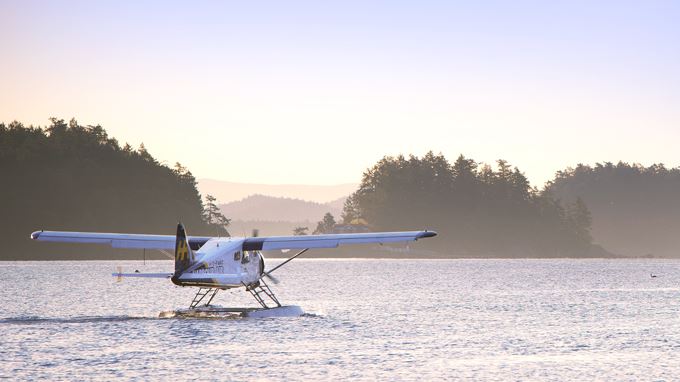
5 Awe-Inspiring Corners of Salt Spring Island
British Columbia’s lower mainland is a busy place. In fact, the entire Pacific Northwest is filled with busy people going to work, going to restaurants, going to the movies and enjoying urban life.
Does that sound exhausting to anyone else?
I love living in Vancouver, but whenever I get a chance to escape and set my mind to exploring something new, something unique; well, I jump at the chance.
A few months ago I had just such an opportunity – a journey to a tiny coastal retreat called Salt Spring Island. Salt Spring was an hour long seaplane ride from Vancouver, but I immediately felt like I was in another country. Suffice to say it was a relaxing trip.
Apart from all of the great things to do in the village of Ganges, here are my top five methods of exploring the wild side of Salt Spring far from the hub of the village.
1. Hiking Maxwell Mountain
The mountain is a favourite of locals and tourists alike, but if you’re looking for a quiet reprieve, the good news is that Salt Spring Island simply doesn’t have a lot of locals relative to the total space on the island.
When you make it to the start of Maxwell’s circuit of trails, make sure you venture off the beaten path. The forest on the mountain leading up to the summit is an adventure straight from the pages of a fantasy novel.
Just be careful though. The mountain rises far from sea level; there are precarious peaks and ledges along the edge of the trails.
Oh yeah, before you go, askthe locals about how to find thefairy ring. You’ll see why.
2. Ruckle Park
Ruckle Park is a combination campsite and day-use park on the furthest southern tip of Salt Spring Island. Adventurers can look for starfish and other marine life between the rocks while simultaneously searching for seals and whales off-shore. If you have a day or two you can watch the glorious sunset and fall asleep to the sound of lapping waves by camping on the soft grass just up from the beach,
3. On The Water
Because Salt Spring is such a small island, kayaking and canoe tours are an excellent way to see the local scenery from a different perspective. Not only will you get a good workout, you’ll do so outside beneath the brilliant coastal sun. Plus, you’ll work up an appetite and have plenty of options for dining once you get back to the dock.
4. Whale-watching Tours
The raw power of the mysterious beasts below the waves is an adventure every human being should experience at some point in their lives. Salt Spring’s whale watching tours gives people a chance to experience wildlife like seabirds, seals, dolphins and of course whales on their turf.
5. Wine Tours & Farms
Heading off the beaten path outside of Ganges gives tourists the opportunity to experience a slower pace of life. The locals living in the Salt Spring countryside are dedicated to the finer things in life, like wine, cheese, environmentally-friendly farming and local art. Many of them sell their wares at the Salt Spring Market on Saturdays throughout the summer, but if you want the authentic experience, renting a car and heading out on a tour is the way to go.
Salt Spring Island has something for everyone, whether you’re setting up shop in town or you’re more of the adventurous sort. The key is to plan not to plan, to go with the flow and turn in whichever direction your spirit moves you.
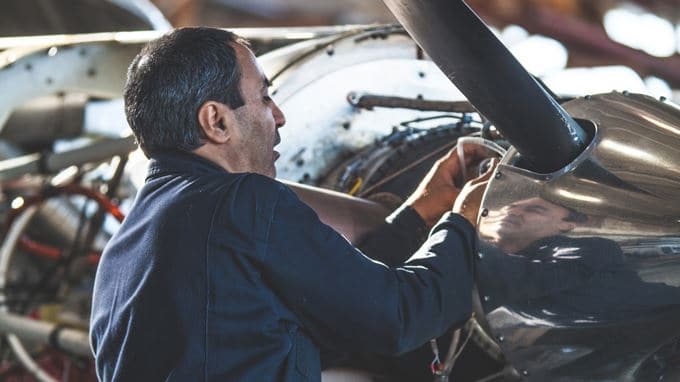
Life in a Seaplane Hangar: What’s Behind the Scenes?
Life in a Seaplane Hangar: What’s Behind the Scenes?
“Hey Kelvin, nice to meet you!”
These are the first words I’m greeted with outside Harbour Air’s large hangar in Richmond, British Columbia. Erika Nixon is Harbour Air’s Maintenance Manager and she’s here to show me around the shop.
This is where the magic happens.
One of the first things obvious to me was how passionate everyone was about working with the airplanes. The atmosphere was buzzing as people moved pieces of wings around, worked on engines and crafted the beautiful machines I get to fly in.
Take it away Erika!
++++
Kelvin: What’s something about the hangar that might surprise someone like me who’s never been in one before?
Erika Nixon: We actually make a lot of modifications to these aircraft. We almost create brand new planes out of old ones we overhaul, we’re constantly improving everything. We like to think of ourselves as classic car mechanics, everyone just loves working on the planes with their hands.
Is that why people like working here? To scratch that mechanic’s itch?
For sure. It’s a very unique operation. We’re the one of the largest seaplane airlines in the world and it’s a unique opportunity for all of us. We modify the aircraft to improve them. You see the panoramic windows on that one? That’s a modification to the aircraft, we’re constantly making them better.
So you can take different parts out and swap them with new pieces?
Yep, you can see the original windows on the Otter over there, they’re quite small, so this allows a little bit more viewing pleasure for our passengers. We rework the dash, we also do repair on our flight controls, our wings, basically making sure that everything is top-notch. Of course we work very closely with Transport Canada. Everything that changes has to go through them for approval.
What does everyone’s background look like? Is the appeal to work on machines and work with their hands? Are they mechanics?
Yep, you bet. That’s how it starts, people passionate about working on machines. Then there’s a lot of education and on-the-job training that goes into working on any aircraft in the world. Because we’re a specialized aircraft, seaplanes, we develop our own unique training programs, something that our training coordinator oversees and runs. Everybody who works on an aircraft has to have a Transport Canada approved maintenance course and then they go through their apprenticeship.
It’s like a lot of the other trades where you go through school to become an electrician, you’re not actually an electrician quite yet.
You need to take in the theoretical knowledge and then add the practical knowledge.
Yes. BCIT is one of the institutions that is accredited by Transport Canada, so some of our people have gone through BCIT. There’s also Northern Lights, they offer another accredited course. There’s a variety of different locations that offer these courses. When they come and do their apprenticeship time with us, they fill their log book out, then they complete their Canadian Aviation Regulations exam and finally Transport Canada issues them a license to work on aircraft.
Is it similar to becoming a pilot then?
It is a lot of on-the-job training for sure in that sense. We have a saying in this industry, “the day you stop learning is the day you should get out of the industry”.
No kidding. That should be every industry, right?
Yeah, one would hope, right? (laughs) You’re constantly wanting to learn, there’s constantly elements to improve upon. Obviously, it’s a safety-critical environment, so that’s our highest priority.
Everything I’ve learned about Harbour Air so far is married to safety.
It’s our number one priority.
And people can be safe and concentrate on their work and do fun stuff while they’re at it.
Exactly. We’ve got a great team environment, and we’re lucky in this environment to have people who’ve been working on this type of aircraft for decades. I did an experiment a few weeks ago because I wanted to see how many years total experience we have here in this department, it’s in the hundreds of years.
Really? That’s awesome. Did you find an actual number?
Yep. So there are three different types of aircraft: Beaver, Single Otter and Twin Otter.
For Beaver, it’s over 575 years of experience. Singles it’s 443 and Twins: 233 years of combined experience.
Wow.
It’s pretty spectacular. Like, it’s staggering, actually. We are very lucky, we have a ton of experts on these type of aircraft with a ton of experience and that’s why a lot of people come to us to work on our aircraft. A lot of private owners and a lot of other companies as well.
Private owners come to you as well?
Yep. Beavers, Turbo Beavers, Cessnas – people own them and they want them well taken care of.
So you’re basically the all-encompassing mechanics of the sky.
Yes, exactly! We operate as Aeroflite International Service Ltd.
Awesome. So what area are we standing in right now?
This is the structures area. They work on the structural repair of our components and our aircraft. They can work on rebuilding the floats, you can see they’re stacking up flight controls here. Bits of the tail and the wing basically. We can take anything apart and swap it for an improvement. Even the seats are removable. We can repair those, the seat upholstery undergoes some wear and tear. We have an upholstery place in Victoria that helps us out with that.
We’ve talked a lot about how the shop runs and how everyone else works – how about you, Erika? What brought you to Harbour Air?
Me? (Laughs) I just know I work with an amazing bunch of people. It’s rewarding to come to work every day.
++++
Erika Nixon’s seaplane hangar is a hive of activity.
There’s moving parts, moving people and lots of work. It’s fascinating to see the enthusiasm that each person has for their own part in the construction of an aircraft. When that plane is up in the sky, its flight is dependant on every component doing its job, and down here on land is no different.
Just like the plane itself, the hangar is just as strong as parts its made from.
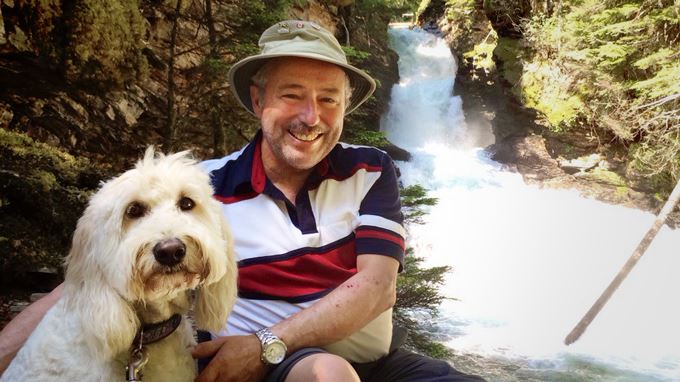
Warren Randle : A Celebrated Pilot’s Lifetime of Adventure
Meet Warren Randle, a legacy at Harbour Air Seaplanes. An aviation veteran of over 25,000 hours in the air over his adventurous career. Warren has now settled in to enjoy retirement in Nanaimo, British Columbia, but not without a story to tell. Warren holds his career close to his heart, because for this pilot, the journey wasn’t always about the ups as much as it was about the downs.
These days Warren spends most of his time on land; lucky for us, I was able to catch up with him to learn more about a lifetime of exploring the world.
Kelvin: How did you arrive at Harbour Air?
Warren: For five years in the early 90’s I was working for Kenn Borek Air. They were contracted to Harbour Air during the summer seasons. Kenn Borek had a lot of Twin Otters and they leased to Harbour Air at the time. So, for four months every summer I would work there, flying Twin Otters up and down the coast, moving fisherman, loggers and tourists.
When I wasn’t flying contract for Harbour Air, I was away from home seven to eight months of the year. I was in Antarctica for five months every year, and two months in the high Arctic Circle working with the military, polar expeditions, climbers and scientists.
Even though it was fantastic, exciting work, I left in the summer of 1994 because I wanted to be at home to raise my kids. I loved working at Harbour Air, I was always impressed how CEO Greg McDougall ran the company, especially how proactive they were on safety and employee relations.
It’s never easy making the decision to walk away from something you know so well, something that’s familiar.
Honestly, it really was. I was willing to start at the bottom if they were willing to have me and they were. So here I am 20 years later after being hired on July 11th, 1994. Nobody could believe I would give up an adventurous job traveling around the world, but the world didn’t matter as much to me as my world here at home. My career was very important before Harbour Air and it was a huge change, but Bill Pennings, chief pilot at the time, took me on and he decided I’d be a good fit because of my experience in single or turbine engines. It was two steps back and one step forward, but it was worth every bit of it, being home every night was more appealing than the major airlines.
The first seven years my family and I lived in Prince Rupert where I flew for Harbour Air on the north coast. It’s a very challenging environment and it was a challenging place to fly, the north coast is very windy, the tides are twice as high there, 23 to 26 feet every six hours. It can be very difficult to fly the Hectate Straight and gauge where you can land, it’s almost too rough especially in storm force winds.
It was a challenging environment for the whole family. In Prince Rupert it rains 300 inches a year and half of that is horizontal due to high winds. I can remember crossing Main Street with a baby in the stroller, a toddler in hand, and bags of groceries hanging from the stroller. Moments later, after a gust of wind, the traffic had all stopped while motorists helped us chase down groceries and pick up our kids who had been blown over, along with the baby carriage. I can’t believe how my wife put up with those years, having being raised in a desert climate! When Harbour Air President, Peter Evans, gave us the opportunity to transfer to the south coast, we chose Nanaimo.
Aviation is a challenging yet rewarding industry to work in. What are some of the challenges you or other peers of yours have faced?
Well, I love my wife and being away from home eight months of the year is a tough situation. Other airlines are similar, it’s very tough to keep your family life intact. I didn’t want to go down that path. I keep telling people here, if they have a family, they have the best job in the world. The equipment is safe and because it’s a seaplane you’re home every night. Go and find that, along with decent wages, health benefits and employee perks anywhere else in the world and then come talk to me.
In 2008 you were diagnosed with cancer. What is it about your career that’s helped you get past that?
Thank goodness for me, I got cancer in 2008 and I’m still supported by Harbour Air. For those of us who’ve needed the help, it’s been a godsend. We still have a house, I’m raising three daughters and I’m still unable to work. It’s a sacrifice but we feel very lucky; maybe you’ll never fly skis in the Antarctic but so what? Here it’s challenging, there’s always things to learn and there’s always someone willing to lend a hand.
My last flight was on June 18th, 2008 and I was diagnosed a few weeks later on July 1st, 2008. I had one last flying opportunity and it was an extraordinary one that happened two years later, during the 2010 Winter Olympics. The chief pilot at the time, Cec Sampert, was chosen to fly the Olympic flame along with its entourage from Salt Spring Island to Cowichan Lake for the 2010 Winter Olympics. Cec phoned me and asked me to fly with him one last time. I was well, I had been out of the hospital for awhile, but what a fantastic way to go out! Thanks to Cec Sampert, my last flight was in October of 2010.
Is it true you’ve logged over 25,000 hours in the air?
(Laughs) That’s true. Experience flying aircraft varies, depending on where you fly, what type of aircraft, and when you flew. 20 years ago, regular days off only existed for the pilots flying for the major airlines. For those of us flying aircraft under 13,000 pounds, flying six days per week with the seventh day on call was normal. Working seven days per week was industry standard for us and logging 1,200 hours per year was common.
Thankfully, the flying industry has become much more civilized and safer. Harbour Air’s current chief pilot, Art Booth, submitted an application to Viking Air which owns the rights to the de Havilland Aircraft, on my behalf. They have a medallion program to recognize the hard work of pilots who have flown de Havilland Aircraft types for more than 5,000 hours. I recently received three of these pins and certificates for which my family and I are very grateful. The certificates included a poem called High Flight, which is a famous piece of literature often quoted. It’s even been read on the moon.
You’re not flying these days, but you’re still close with the team at Harbour Air.
I had a phenomenal 34 year career and before my diagnosis, I would have worked ten more years, I was feeling great. Harbour Air is a dream job and I would have happily stayed as part of the crew.
I’m heading to Vancouver tomorrow actually to visit, staying tight with my colleagues at Harbour Air who have been so supportive. They have flown me to every appointment, back and forth to Vancouver General from the first day. They even did some crowd-funding. There was a three month gap between my holiday pay running out and the time long-term disability kicking in so Alicia, the Base Manager in downtown Vancouver, organized some fundraising events for my family. I haven’t seen her for a long time so I am taking my daughter over there tomorrow to see her and hopefully buy her a bowl of soup and give her a hug.
You know, it’s terrible that people have to get sick to have these experiences with those around them, but the support that comes through, the friends who stand by your side…
I know, it’s remarkable. My Harbour Air friends have always been there and they are like family to me. Every time I go there they’re so friendly and so kind. I can’t wait to see them tomorrow.
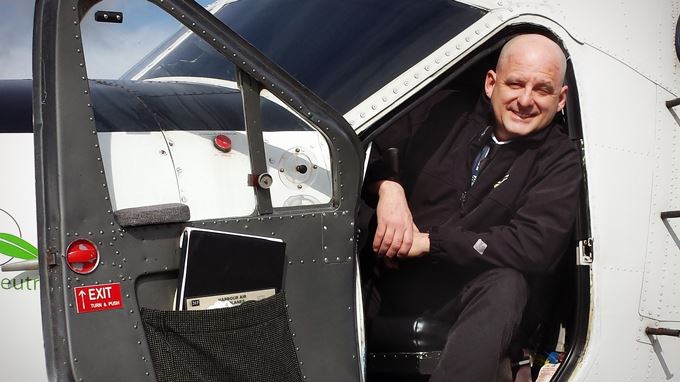
Dan Cummins and a Life Spent in the Clouds
Catching up with a seaplane pilot isn’t always easy to do in the traditional sense, considering that their office is usually in the sky. Anyways, Pilot Dan Cummins was more than happy to hook up over the phone from Victoria to share a little bit about a life spent around seaplanes.
Kelvin: How did you arrive at Harbour Air?
Dan: It all started when I was really young, my grandparents lived on the coast in Ocean Falls. They were right beside a float plane base and I fell in love with them really early, watching them take off and land in the water at an early age. I was hooked. I went and took lessons right out of high school before going off and doing other things. Around 30 I came back to the industry and got my license and certification all taken care of. My first real job was through a mutual friend and I got hired as a first officer flying a Twin Otter in the Maldives, which was really cool. I did that for a year and half before landing a job in Vancouver with West Coast Air. I worked as an first officer for a year and then started flying a Beaver as a captain.
What are the main differences in responsibilities between a first officer and a captain?
As a first officer, you’re sitting beside the captain and helping take care of the aircraft, the passengers and the overall flight. Single engine aircrafts only have captains, they take care of everything. On twin engine planes the first officer is usually a junior pilot, learning more about the path to becoming a captain. Today I’m actually flying as a co-pilot and a captain. You build experience and time in the right seat as a co-pilot before getting hired as a captain, and after that experience you’re good to get a job higher up.
Higher up, literally! Sorry. Anyways, it sounds like the training is all built in.
Right, the training is built in because Harbour Air is very tough company to get into. We’re lucky because we’re one of the best if not the best float plane companies in the world. It’s tough to get a job, the standards are so high.
What’s your favourite thing about your job?
It’s funny, I’ve done every job you can think of – construction, a paper mill, I’ve done a lot of real jobs. This is a real job too, but it’s one where I actually enjoy going to work in the aviation industry. I look forward to flying a plane, which is cool, it’s fun.
Harbour Air, as an employer is really getting better every year. I’m going into my tenth year! The core values of the business include health and wellness, it’s really fitness orientated, we all ride bikes and do triathlons together. It’s a really good group of guys to work with, a cool culture that’s developed over the years. Greg McDougall (Harbour Air’s owner ) is really big into cycling, he does the BC Bike Race, Whistler GranFondo, Tour de Victoria and more. He really encourages people who want to enter races. The company keeps me young and healthy!
Do you have a favourite event or a place you find a way to visit every year?
Whistler, definitely. We go a couple times each year just to spend time there. We fly in the summer, that’s always nice. Whistler Air’s operations usually start at the beginning of spring and it’s a fantastic route to fly, sure does make it easy to get there. We fly to Vancouver Island once or twice a year too, but definitely Whistler is my favourite to go to at least two weekends a year in the summer. We’re more of a biking/hiking family, not as big into winter sports. The kids like to do nothing so it’s a bit of a challenge, but we force them out of the hotel where there’s no wifi.
What are your 5 favourite places to visit when you’re not working?
- 1. Whistler: I love to run the Lost Lake Loop.
- 2. Seattle: The kids really enjoy the Pike Place Market. I’m a huge fan of the duck tours in Seattle, the vehicle is amphibious, it actually goes in the water. They put on a show and you get a history lesson as well, it’s great. A little campy, but I think it’s hilarious.
- 3. Vegas: I most enjoy driving out of the city and seeing the Hoover Dam and the Grand Canyon tour.
- 4. Oregon Coast: Just hanging out eating oysters on the beach. It’s awesome.
- 5. Palm Desert: Riding my bike in palm desert; the bike lanes are massive, it’s flat and the temperatures are perfect.
I’ve heard a rumour that you’re quite popular with the celebrities who fly in and around the lower mainland. Got any cool stories for us?
Sully Sullenberger, the guy who crashed the Airbus into the Hudson River. He sat up front with me during the Olympics. He told me everything that happened, it was remarkable.
Paul Bettany and Jennifer Connelly, I flew them and their two kids out to Tofino. They were incredibly nice, they’re both into hiking, Jennifer Connolly is really into the outdoors. I also met Harrison Ford when he was here a few years ago too, he was flying to do a movie.
The best one though was Burt Reynolds, he was dressed in all his 70’s gear.
Oh man, did you call him on it?
(Laughs) It was for a movie too. I really wanted to ask him if that’s what he wears all the time though. I wisely thought better of that idea, however.
++++
A veteran pilot who’s seen most of the world from up above, Dan Cummins is still a kid at heart after all these years. Ironically, he’s humble and remarkably down-to-earth, a man who’s been passionate about flight and travel his entire life.
“It’s just always an amazing experience. You get to fly around in an airplane, meet cool people and see incredible things. I once saw a group of about 20 humpback whales breaching and we circled them for 20 minutes. That was something else. I get to see different whales all the time, below the water while I’m up above it. Every day is an adventure to somewhere new for myself and the passengers.”
– Dan Cummins
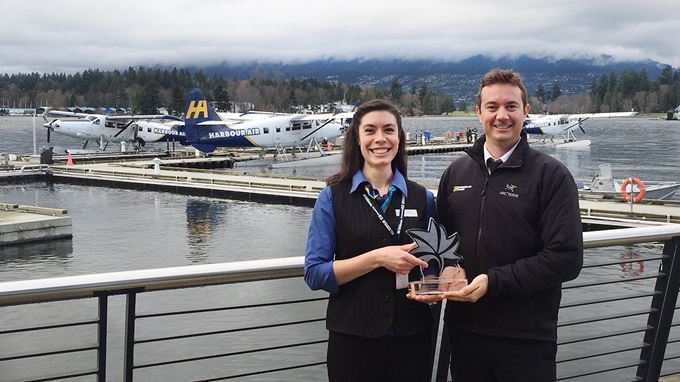
Harbour Air Voted Traveller Experience of the Year
Ottawa —Harbour Air Seaplanes, the world’s largest seaplane airline, has been voted the top tourism experience in Canada by the Tourism Industry Association of Canada (TIAC).
The VISA Canada Traveller Experience of the Year award was awarded to Harbour Air at the TIAC annual dinner in Ottawa.
“We are truly honoured to be recognized by this national organization for such a prestigious accomplishment,” said Harbour Air founder and CEO Greg McDougall. “I want to thank our employees for their incredible dedication to creating exceptional travel experiences and providing a high level of customer service for our guests”.
Harbour Air was among 14 other organizations honoured by the Tourism Industry Association (TIAC) of Canada as a recipient of the 2015 Canadian Tourism Awards.
The Visa Canada Traveller Experience of the Year award recognizes companies that have gone above and beyond, offering travellers superior tourism experiences in Canada. The Canadian Tourism Awards are presented annually recognizing success, leadership and innovation in Canada’s tourism industry.
Harbour Air operates a fleet of Canadian made de Havilland Beaver, Single Otter and Twin Otter aircraft renowned the world over their capability, reliability and history. Harbour Air Seaplanes has been in business for over 33 years and transports over 400,000 passengers throughout coastal British Columbia every year.
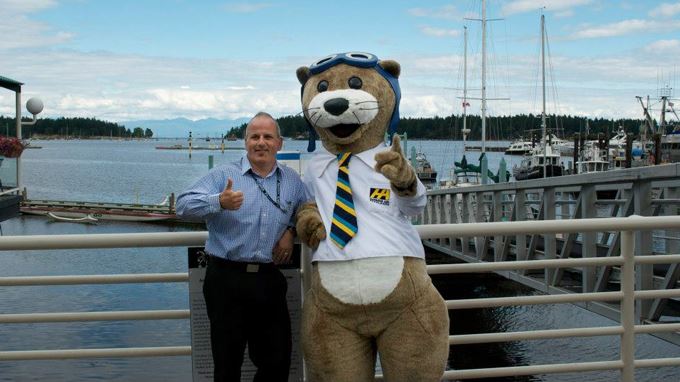
Travelling the World in a Bathtub with John Winter
If someone stopped you on the street and asked you what bathtub racing, the Isle of Man, Nanaimo, Harbour Air and British Columbia have in common, would you be able to answer?
No? Well, I’m here to help.
The answer: John Winter.
Let me explain. The Isle of Man is a small island in the Irish Sea. If lines were drawn between Scotland, England, Wales and Ireland, John Winter’s hometown of Castletown, on the southern tip of the Isle of Man, would be directly in the middle. From this staging ground has grown one of the world’s most intense annual competitions: The World Tin Bath Championships.
Now, out of the billions of places in which one could live on this planet, can we agree that it’s rare for someone to live in just one city with a proud bathtub racing heritage? We can? Alright then, what are the chances of living in TWO such cities in the same lifetime?
It’s a distinction John Winter is blessed with and proud to share.
John is the base manager of Harbour Air’s Nanaimo terminal. I caught up with John to learn more about his lifelong obsession with travel and his knack for winding up in bathtub-centric cities.
****
Kelvin: How did you arrive at Harbour Air?
John: I’ve spent the past 22 years in aviation and travel in some capacity. I got started working in the industry in Great Britain as an 18 year-old at the company that would later become British Airways. I began in reservations and ticket sales and from there I progressed into sales and marketing before striking out on my own as a travel agent for about a year. After that I spent about two years out of the travel industry backpacking.
So you weren’t working in travel for that year, you were just travelling yourself.
Right, I suppose so (laughs). Whether I was backpacking or just travelling in general, I was crazy about finding new places to visit. In that two year window I spent time in the USA, Australia and New Zealand before coming to Canada and getting back into working in the travel industry.
How did you start working with Harbour Air?
I initially started doing temp work in Coal Harbour, so I could see the planes taking off every day. It was so beautiful, seeing all the activity. One day I wandered down at lunch and basically asked for a job out of the blue. I met with Chad Wetsch who invited me for an interview and he offered me a position in the freight department, which was new to me and I was happy to take. It was a new job in a new company, a new challenge. I worked there for three years, learning the ropes of that end of the company before becoming the company’s freight supervisor. Then the position in Nanaimo opened up and I couldn’t resist the opportunity to live in another place, to travel somewhere else. That was six years ago in August and here I am today. Just like Coal Harbour, I see the dock every day from my office in the Lighthouse Building. I see the planes taking off and the new people coming to visit.
What are some of the common questions you hear in your position?
We get asked how big we are all the time, which can mean a couple different things. We’re actually one of the world’s largest seaplane company with over 40 aircraft: the DeHavilland Beaver, the Otter and the Twin Otter. They truly are legendary Canadian icons.
With regards to people, we’re a completely self-sufficient company. This means that we don’t need to hire other companies or contractors to maintain our aircrafts. In the summer we have over 300 staff members at 9 different locations. There are dock operations and the Customer Service Agents, the people who load the aircrafts, take reservations and are the front lines, the people who deal with our customers.
From there we have ground transportation crews and maintenance specialists, the people who do mechanical work, paint the planes, and then there’s the quality assurance that comes along with that.
We manufacture things for ourselves, we know our own product inside and out. Other airlines will actually come to us to buy parts or to paint their planes or service them.
Another common question is just where do we fly to and how much does it cost. People are surprised at the price because typical airline travel is really expensive because of how long it takes to get places. People are surprised because they can leave here and be checking in to a flight within an hour at the international airport in Vancouver, and it’s actually quicker to get there from Nanaimo then it is from Abbotsford.
What about some of the common myths of seaplane travel?
It’s expensive or it’s not reliable. We actually won an award called the Cumberbatch award for our safety record because of how we report hazards or issues we come across. Safety is the key for the entire company. It’s our number one priority. We’re all trained to identify and follow up on hazards on the aircraft, on the dock or even in the office. It’s a whole system, it’s part of the interview process, having the right to say no if something feels unsafe. We’re dealing with people and their lives.
What’s your favourite thing about living in Nanaimo?
The absolute best part of this city, I mean there are lots of cool places to visit, lots of authentic west coast spots, but the coolest thing is the International Bathtub Championships. Every July people get together and build bathtub boats, an old school bathtub built on a fiberglass hull with an outboard motor. The trip is 36 km around the harbour, around the straight of Georgia, around the Chelsea islands and finishing in Departure Bay right here in town. The race takes about three hours, these people are on their knees in a bathtub in the ocean for three hours.
I’d need rescue immediately, no question.
It sounds crazy and it is, but these people are incredible. Imagine taking your bathtub, strapping an outboard motor on the back and just hoping for the best. People get investors and backing for their boats, they have people with a chase boat in case you do need rescue. The champions every year arrive at the beach and they have to jump out of the boat after three hours at sea and they race up the beach to ring a bell on shore to win the race.
The really weird thing is that back home on the Isle of Man we had a similar race, just minus the motor. We used the old style tin bathtubs, you have to build a boat that will float long enough to get across the harbour beside Castletown.
Wait, there are bathtub races in other places in the world? And you’ve lived in two of these cities? Come on…
I know! (laughs) So the two places I’ve spent the majority of my life in, they both have this immense passion for navigating the ocean in a bathtub. I don’t know what it is, I guess I just attract that sort of sense of adventure wherever I go!
***
John Winter’s race might be a slow one, but it’s certainly been steady. His is a race to experience more, to meet new people and tackle new challenges. He’s lived in different countries all over the world because of an innate desire to see what exists beyond the clouds.
Through his travels, John has gained multiple perspectives of the world’s diversity; the sort of perspective one can only find after watching bathtub races on opposite sides of the planet.
And after settling in our little corner of the world, the sky’s the limit for John and his family.

